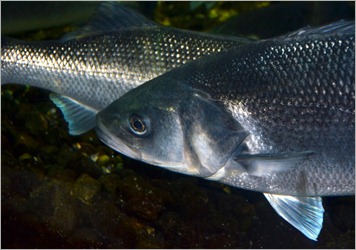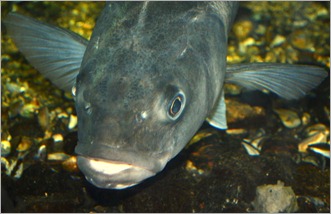Alan Vaughan – Hooked on Bass 1988
_______________________________
I can cast a fly from a boat to a 100lb Tarpon on a #7 rod. Tarpon flies are not very big, they’re certainly not bigger than a regular fly I might cast to a bass here in Wexford. However I would have a LOT of trouble landing a 100lb Tarpon on a #7 rod, whereas, if I wanted to cast a big autumn bass streamer into a southerly force five on a cool November day on the same gear I would also have a pile of trouble! I need to go up a couple of sizes, but I want my gear to remain in balance with the size of fish I’m trying to catch.
There’s a lot going on here, flies, lines, rods, fish size, conditions, casting, fighting fish!
Saltwater fly fishing for bass is not easy, or rather, fly ‘casting’ for bass is too often the very difficult part of it, if not the most difficult, part for many people. I’m on a constant search for ways and means to make it easier both for my customers and myself. One of the
 se ‘ways’ that I have spent a hell of a lot of time on is turnover and fly delivery for bass.
se ‘ways’ that I have spent a hell of a lot of time on is turnover and fly delivery for bass. I want my fly to land where I want it to be and I want to connect and control it immediately after it has landed.
Sometimes that’s not easy, in fact its downright bloody tough!
Under reasonably ‘normal’ circumstances most people can cast to bass or mullet or seatrout – anything from a light saltwater #6 through to a #7 will cover the fly size and fish perfectly. In sheltered estuaries its often all that we need. Taking a #6 or #7 out onto the open windy coast with bigger flies however has its limitations! Rather than fly size dictating the gear we use, oftentimes conditions are now setting the bar.
And lets face it, isn’t this where its at a lot of the time? Windy over the right side, waves breaking, rocky shores, line management, bigger flies – opportunities for bigger fish. We need all the help we can get. I am convinced of one thing though – good turnover at fifteen or eighteen yards is worth much more than dumping the fly at twenty five or twenty eight. And this is where we CAN do it easier and more effectively even though its tough!
Don’t think distance (and often having to deal with the subsequent recovery) think getting closer, more accurately and with a better ‘straight to’ swim - IMMEDIATELY.
If you are one of those lucky people who can cast nice flies into strong head winds a considerable distance with good turnover and still manage the line – awesome!
And if you are not?
What are we exactly required to do? What is it that saltwater bass fishing requires of our fly casting and fishing in these circumstances? How do we make it easier?
- On a rocky windy coast with rising tide
- Early tide steps
- We are casting and moving from target to target – nearly always
- We need to fish early in the rise with a floating or very slow intermediate line –
- Turnover and delivery needs to be excellent
- A longer polyleader on the floater – 10’-0” (float or slow sink)
- A shorter polyleader on the inter – 8’-0” (slow sink)
- A fly that rides high ‘hollow fleye’ tied dense, or popper
- To some extent we are often casting at or close to very specific possible white water locations or to fish we can see
- Some accuracy is required especially if sight fishing (rarely)
- We are not drifting flies
- We are not blind casting
- We don’t cast constantly
- Its likely we will see some fish
- We are thinking very quickly
- We don’t need to cast far, fish are always just behind the waves following them in to pick up opportunities
- Expectations of big fish are high
- Flies are often fished fast in shallow water – stopped when possible
- CASTER SKILL – distance decreased – accuracy high – turnover high – line management medium
- Mid tide steps
- We are pushed back from our targets, faster and more frequently
- Water depth is increasing and with wave activity a switch to an intermediate is good
- We will need to increase our casting distance a little
- The density of our fly is decreased, its getting down a little more
- The size of our fly is increased a little
- Switch to a shorter leader on the intermediate – 6’-0”
- Our chance to drift flies may increase – change to a floater with an intermediate polyleader if the opportunity presents
- Less accuracy is required
- Turnover needs to be good
- Our ‘blind’ casting increases more and more to remembered ‘hot spots’
- Retrieve speeds vary – mid water
- Expectations of big fish decrease
- CASTER SKILL – distance increased – accuracy decreased – turnover increased – line management high
- High tide steps
- We are a considerable distance from our initial start
- Water levels are much increased
- Fly size is increased again
- Sink rate of leader is increased if remaining on intermediate line
- Depending on location (tidal movement) a change of line to S3 or similar might be strategic
- Leader length is decreased – 4’-0”
- Blind casting increases
- Expectations of bigger fish increase again
- Distance is not a requirement
- Flies are fished slow and down (depending on overall depth presented)
- CASTER SKILL – distance decreased – accuracy decreased – turnover good – line management medium
- Some further notes here – Little casts for bigger fish
- Early tide steps







